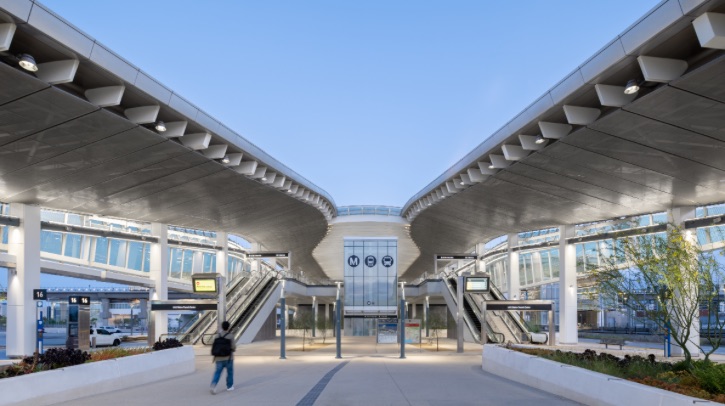The LAX/Metro Transit Center Station has opened for service. Designed by architecture practice Grimshaw, together with architect Gruen Associates and engineering company Arup, the station is part of the wider Landside Access Modernization Program underway at the airport, which is creating a fully intermodal facility and a new point of arrival into the city.
End-to-end passenger journey

Located at Aviation Boulevard/96th Street, the station spans more than 335m from north to south and includes a bus plaza, bus hub and customer service center. With the widest light rail platform in the Metro system, its two main levels are designed to provide a welcoming, convenient and secure connection point that offers riders access to a wide array of destinations throughout LA County.
“It serves as a new iconic entry point for air travelers arriving in Los Angeles,” said Debra Gerod, Gruen Associates’ partner-in-charge.
Skylights, canopies and glazed screens have been included to establish a light, spacious environment that reinforces intuitive wayfinding. This journey extends to the wide above-grade concourses, which are flooded with natural light. At ground level, bus bays are integrated into a landscaped public plaza that sits between the bus canopy structures.

Occupying a previously industrial site, the LAX/Metro Transit Center Station is designed as an open space that leverages California’s coastal climate by adopting passive design strategies for comfort, including shading by canopies, natural daylighting through skylights and natural ventilation.
Futureproofing the station, the design includes PV panels in adjacent landscaping and infrastructure that will support future EV bus charging. The project is targeting LEED Gold.
The public plaza, a mezzanine at concourse level and other public spaces within the station, including a bike hub, are intended to provide moments of respite and comfort in this transitory environment and feature integrated artwork. Externally, drought-tolerant native planting increases the biodiversity of this urban, transportation-oriented place.

Sustainable traffic growth
According to the architects, LAX/Metro Transit Center Station will “dramatically improve the travel experience” for visitors to upcoming cultural events, such as the FIFA World Cup 26, Super Bowl LXI, and the 2028 Olympic and Paralympic Games. The introduction of these new transit services to LAX is expected to increase ridership and reduce the number of personal vehicles in the terminal area. With an estimated 5,000 daily boardings by 2035, the station will be instrumental in easing traffic congestion and improving mobility.
This construction has also made the K line a fully functional connection in the metro’s network. Connecting Metro’s C and K rail lines, this new station closes the final gap along the K line, marking an important step forward in the city’s effort to reduce car traffic at LAX and decrease reliance on more costly options, such as taxis, rideshares or private vehicles.

“The LAX/Metro Transit Center Station will help relieve congestion and enable sustainable and equitable access to the airport without the need to drive into the central terminal area,” said Simon Rees, principal at Arup.
“The Metro Transit Center Station transcends the typical function of a transit hub, emerging as a significant civic landmark and gateway to the city’s transport network,” said Andrew Byrne, managing partner of Grimshaw’s LA studio. “A hub of multimodal activity, the station also exemplifies the importance of thoughtful infrastructure to accelerate the necessary shift in our cities: fostering economic vitality and equity and improving the quality of life for residents and visitors alike as Los Angeles moves toward a more sustainable and connected future.”
In related news, Rome’s Fiumicino Airport recently opened a check-in and baggage delivery service in the center of Rome

